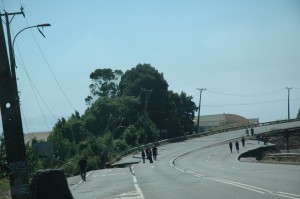 When I awoke, the earth had settled into occasional convulsions. It was finally safe enough to return to our campsite. The picturesque campground that we had come to enjoy was in a shambles. Most of the shelters were damaged, with tables and benches overturned. All of the docks had been knocked off their piers, and the most shocking of all was to see just how far inland the lake had flowed. There was a line of debris more than 15 feet from the banks edge. Two feet beyond that was a long ripple in the earth. It looked like the bank was frowning at the lake.
When I awoke, the earth had settled into occasional convulsions. It was finally safe enough to return to our campsite. The picturesque campground that we had come to enjoy was in a shambles. Most of the shelters were damaged, with tables and benches overturned. All of the docks had been knocked off their piers, and the most shocking of all was to see just how far inland the lake had flowed. There was a line of debris more than 15 feet from the banks edge. Two feet beyond that was a long ripple in the earth. It looked like the bank was frowning at the lake.
Everyone was still in a state of shock, and were mostly quiet as we disassembled the tents, and packed up what survived in the shelter. We had originally planned to leave on this day, so almost everything had been packed into the Jeep before going to bed the night before. All that had remained in the shelter were the French press, cups and a few utensils for the morning. The French press now laid in the dirt, shattered into pieces; not very fortuitous, considering that there would be no electricity at home. We could live without many things, but I wondered whether coffee was one of them.
With the cars packed, everyone took advantage of the running water. It was to be our last shower for a long time, not to mention flushable toilets. We didn’t know what we’d find in Concepcion, but were fairly certain, from the news, that we would be back to camping… this time indoors.
Before leaving Lleu Lleu, we stopped at a small mercado (store) to buy supplies and gasoline. As we drove, I made a quick list of things not to forget: agua, candles, toilet paper, crackers, veggies, batteries, and pasta. Although without electricity, the young store owners had opened the doors to anxious shoppers. Virtually all of their inventory lay on the floor in huge mounds, blocking access to the aisles. Patchie and I stretched, contorted and dug to reach items that would be essential to our new state of existence. While we foraged inside, Sergio and the storeowner used a funnel and large containers to pour gasoline into the tank. Without electricity, there would be no functioning gas stations on the route home.
With the car packed with the additional supplies, we began the slow trek to Concepcion. Tension and blood pressure were high as we listened to the radio. Reports of collapsed buildings and homes, tsunamis that had carried away entire communities, fallen bridges and constant tremors wreaked havoc with our nerves.
Talcahuano, where René and Patchie lived, had been devastated by tidal waves.
The once smooth Highway 160, a testament to progress in Chile, was in ruin. Branches were stuck into crevices and craters to mark the damage. Just north of Curanilahue, a bridge had collapsed, and we were forced to detour onto a narrow, rocky dirt road that ran through a eucalyptus farm.
Bio Bio Radio continued to report the devastation. Most houses and buildings along Bulnes, a street in Concepcion, were destroyed. Eighty percent of Dichato and most of Pingeral, both ocean-side communities, had been washed away by a tsunami. It would be weeks before we would learn that the coast of Lebu, a town not too far from Lago Lleu Lleu, was raised almost ten feet, too incredible to imagine.
We drove in tandem until reaching Lota. Rene needed to drive his son Max’s girlfriend Pamela home. So Sergio and I waited at Playa Blanca (White Beach) to rendezvous. While waiting, I thought about how frantic her family must have been to not have her close, and then wondered about my own family back in Buffalo. By that point, the earthquake had to have been in the news. We had left so soon after returning from Pucon that I didn’t have time to email regarding our additional travel plans. As far as they knew, we were home in Concepcion. Given electronic news’ penchant for televising the most dramatic, I was certain that they would be distraught.
The radio continued to broadcast news of the quake. The old bridge at San Pedro de la Paz, a community across the Rio Bio Bio from Concepcion, had fallen, leaving two bridges standing. The most commonly used bridge to cross into Concepcion was open to only emergency vehicles. Upon reaching San Pedro, we found traffic backed up, with cars and trucks forming several lines, waiting to cross. After waiting for half an hour to see if traffic would be allowed through, we turned around to see if the third bride was open. I prayed that it would be. The thought of being so close to home and not being able to pass was more than I wanted to think about. All I wanted to do was go home, take stock of what we had to deal with and roll up my sleeves. I breathed a sigh of relief when we able to cross over. It would be my last easy breath for awhile.
Next Post: Another City in Ruin